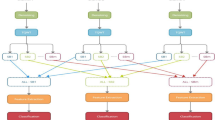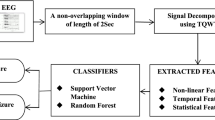Abstract
Electroencephalogram (EEG) analysis has been widely used in the diagnosis of stroke diseases for its low cost and noninvasive characteristics. In order to classify the EEG signals of stroke patients with cerebral infarction and cerebral hemorrhage, this paper proposes a novel EEG stroke signal classification method. This method has two highlights. The first is that a multi-feature fusion method is given by combining wavelet packet energy, fuzzy entropy and hierarchical theory. The second highlight is that a suitable classification model based on ensemble classifier is constructed for perfectly classification stroke signals. Entropy is an accessible way to measure information and uncertainty of time series. Many entropy-based methods have been developed these years. By comparing with the performances of permutation entropy, sample entropy, approximate entropy in measuring the characteristic of stroke patient’s EEG signals, it can be found that fuzzy entropy has best performance in characterization stroke EEG signal. By combining hierarchical theory, wavelet packet energy and fuzzy entropy, a multi-feature fusion method is proposed. The method first calculates wavelet packet energy of EEG stroke signal, then extracts hierarchical fuzzy entropy feature by combining hierarchical theory and fuzzy entropy. The experimental results show that, compared with the fuzzy entropy feature, the classification accuracy based on the fusion feature of wavelet packet energy and hierarchical fuzzy entropy is much higher than benchmark methods. It means that the proposed multi-feature fusion method based on stroke EEG signal is an efficient measure in classifying ischemic and hemorrhagic stroke. Support vector machine (SVM), decision tree and random forest are further used as the stroke signal classification models for classifying ischemic stroke and hemorrhagic stroke. Experimental results show that, based on the proposed multi-feature fusion method, the ensemble method of random forest can get the best classification performance in accuracy among three models.














Similar content being viewed by others
References
Ang, K. K., Guan, C., Chua, K. S., Ang, B. T., Kuah, C. W., Wang, C., Phua, K. S., Chin, Z. Y., and Zhang, H., A large clinical study on the ability of stroke patients to use an EEG-based motor imagery brain-computer interface[J]. Clinical EEG & Neuroscience 42(4):253–258, 2011.
Zhang Y, Ji X, Liu B, et al. Combined feature extraction method for classification of EEG signals[J]. Neural Computing & Applications, 2016:1–9.
Varun Bajaj, Ram Bilas Pachori. Separation of rhythms of EEG signals based on Hilbert-Huang transformation with application to seizure detection[C]. International Conference on Convergence and Hybrid Information Technology, 2012.
Shayegh, F., Sadri, S., Amirfattahi, R., and Ansari-Asl, K., A model-based method for computation of correlation dimension, Lyapunov exponents and synchronization from depth-EEG signals[J]. Computer Methods & Programs in Biomedicine 113(1):323–337, 2014.
Kocadagli, O., and Langari, R., Classification of EEG signals for epileptic seizures using hybrid artificial neural networks based wavelet transforms and fuzzy relations[J]. Expert Systems with Applications 88:419–434, 2017.
Mohammadi, Z., Frounchi, J., and Amiri, M., Wavelet-based emotion recognition system using EEG signal[J]. Neural Computing and Applications 28:1985–1990, 2017.
Shaw L, Routray A. A critical comparison between SVM and k-SVM in the classification of Kriya Yoga meditation state-allied EEG[C]. IEEE conference WIECON-2016. IEEE, 2016.
Yuan, Q., Zhou, W., Yuan, S. et al., Epileptic EEG classification based on kernel sparse representation[J]. International Journal of Neural Systems 24(04):145005, 2014.
Ying Jiang, C.-K., and Peng, Y. X., Hierarchical entropy analysis for biological signals[J]. 236(5):728–742, 2011.
Carlen, E., Carvalho, M., Roux, J. et al., Entropy and chaos in the Kac model[J]. Kinetic and Related Models (KRM) 3(1):85–122, 2010.
Zhang, T.-L., Ding, Y.-S., and Chou, K.-C., Prediction protein structural classes with pseudo-amino acid composition: Approximate entropy and hydrophobicity pattern[J]. 250(1):186–193.
Wen, Z., Du, Y., Yoshida, T. et al., SamEn-SVR: Using sample entropy and support vector regression for bug number prediction[J]. IET Software 12(3):183–189, 2018.
Xin, L., Xiaoying, Q., Xiaoqi, S. et al., An improved multi-scale entropy algorithm in emotion EEG features extraction[J]. Journal of Medical Imaging & Health Informatics 7(2):436–439, 2017.
Kuai, M., Cheng, G., Pang, Y. et al., Research of Planetary Gear Fault Diagnosis Based on Permutation Entropy of CEEMDAN and ANFIS[J]. Sensors 18(3):782, 2018.
Cao, Z., and Lin, C. T., Inherent fuzzy entropy for the improvement of EEG complexity evaluation[J]. IEEE Transactions on Fuzzy Systems 26(2):1032–1035, 2018.
Nicolaou, N., and Georgiou, J., Detection of epileptic electroencephalogram based on permutation entropy and support vector machines[J]. Expert Systems with Applications 39(1):202–209, 2012.
Benzy V K, Jasmin E A, Koshy R C. Approximate Entropy and Wavelet Entropy based Depth of Anesthesia monitoring[C]. International Conference on Control Communication & Computing India, IEEE, 2016.
Cukic M, Pokrajac D, Stokic M, et al. EEG machine learning with Higuchi fractal dimension and sample entropy as features for successful detection of depression[J]. 2018.
Mu Z, Hu J, Min J. EEG-Based Person Authentication Using a Fuzzy Entropy-Related Approach with Two Electrodes[J]. Entropy, 2016, 18(12).
Abdel-Hadi M E A, El-Khoribi R A, Shoman M I, et al. Classification of motor imagery tasks with LS-SVM in EEG-based self-paced BCI[C].Fifth International Conference on Digital Information Processing & Communications, IEEE, 2015.
Xiao W, Jie Z, Li Y, et al. Class-specific cost regulation extreme learning machine for imbalanced classification[J]. Neurocomputing, 2017, S0925231217302199.
Cuesta-Frau D, Miró-Martínez P, Oltra-Crespo S, et al. Classification of glucose records from patients at diabetes risk using a combined Permutation Entropy algorithm[J]. Computer Methods and Programs in Biomedicine, 2018:S0169260718302062-.
Cao Z, Ding W, Wang Y K, et al. Effects of repetitive SSVEPs on EEG complexity using multiscale inherent fuzzy entropy[J]. Neurocomputing, 10.1016/j.neucom.2018.08.091.
Acknowledgments
This study was funded in part by Shanxi Province Natural Science Foundation Project (grant no. 201801D121138) to author F. Li and Shanxi Province Key Research and Development Project (grant no. 201803D31045) to authors Xueying Zhang and F. Li, and the same government department under the Key Science and Technology Projects (no. 20181102008) Scheme to authors Xueying Zhang and F. Li. This study is also funded in part by the National Natural Science foundation of China (NSFC) under the grant no. 61371193 to author Xueying Zhang and Project (No.201301029) of subject Youth Fund of Health Commission of Shanxi Province.
Author information
Authors and Affiliations
Corresponding author
Ethics declarations
Conflict of interest
All Authors declare that they have no conflict of interest.
Ethical approval
This article does not contain any studies with human participants or animals performed by any of the authors.
Additional information
Publisher’s Note
Springer Nature remains neutral with regard to jurisdictional claims in published maps and institutional affiliations.
This article is part of the Topical Collection on Image & Signal Processing
Rights and permissions
About this article
Cite this article
Li, F., Fan, Y., Zhang, X. et al. Multi-Feature Fusion Method Based on EEG Signal and its Application in Stroke Classification. J Med Syst 44, 39 (2020). https://doi.org/10.1007/s10916-019-1517-9
Received:
Accepted:
Published:
DOI: https://doi.org/10.1007/s10916-019-1517-9




